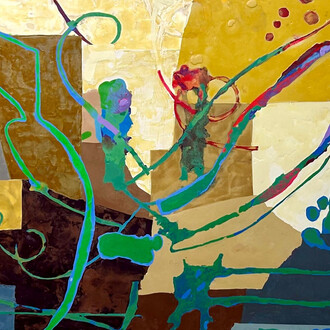The exhibition takes its title from the most recent painting Flaccus completed, in September 2025, and now presented to the public for the first time: a diptych of striking chromatic intensity — “a field of saturated yellow, traversed by green branches and dotted with marks” — which, as Di Capua observes, “seems to speak in a long-lost magical language, in its silent radiance.”
“In my view, a painting is a kind of natural phenomenon, like a tree that has no need of theory to stand tall and let its branches sway in the wind,” Flaccus explains. This image encapsulates his vision: the painting grows, breathes, and feeds on matter — wax, light, and time — transforming the pictorial gesture into a vital process.
The works, executed in encaustic — an ancient technique that fuses pigments with molten wax — emanate a sense of organic balance between matter and light. Each surface vibrates between transparency and opacity, holding the energy of the gesture and releasing it as breath. Layered and incised, color becomes a living substance, moving with slow tensions and releases, evoking natural phenomena: the flow of water, currents of air, and botanical or cosmic metamorphoses.
Di Capua writes: “[…] the paintings themselves seem to breathe. Within the dynamics of a style that has grown lighter, they no longer appear merely as formal structures, but as events in themselves.” Painting, then, that does not represent but occurs—each work preserving, in its transparency, the memory of its own becoming.
Like a fading note, September song lingers in the viewer’s gaze—an echo of color, a trace of inner time that seems to drift beyond the painting’s surface.
(Essay by Marco Di Capua)














